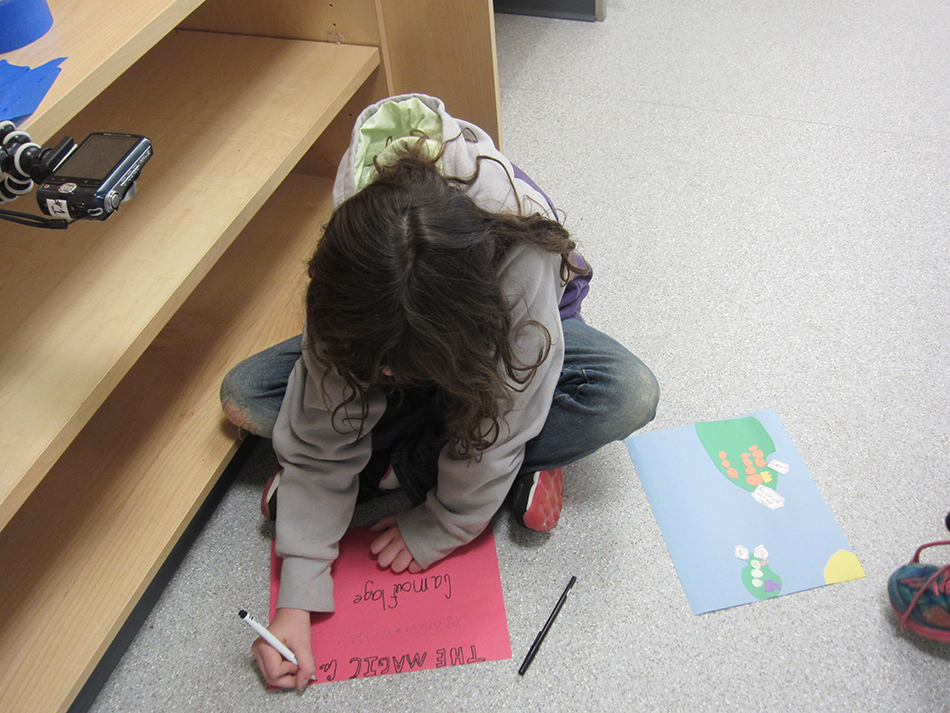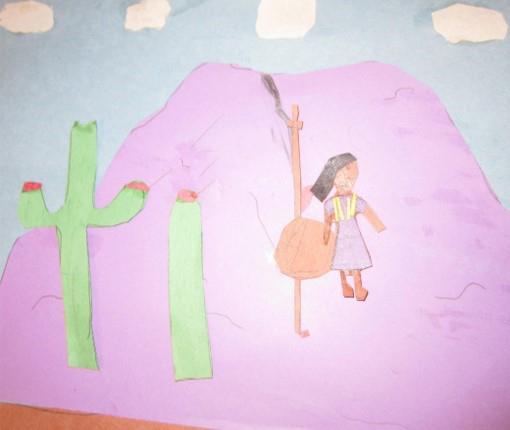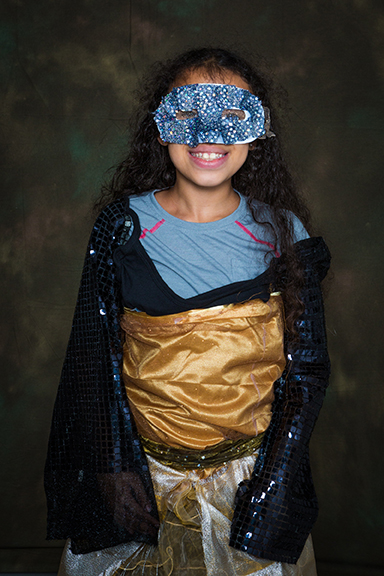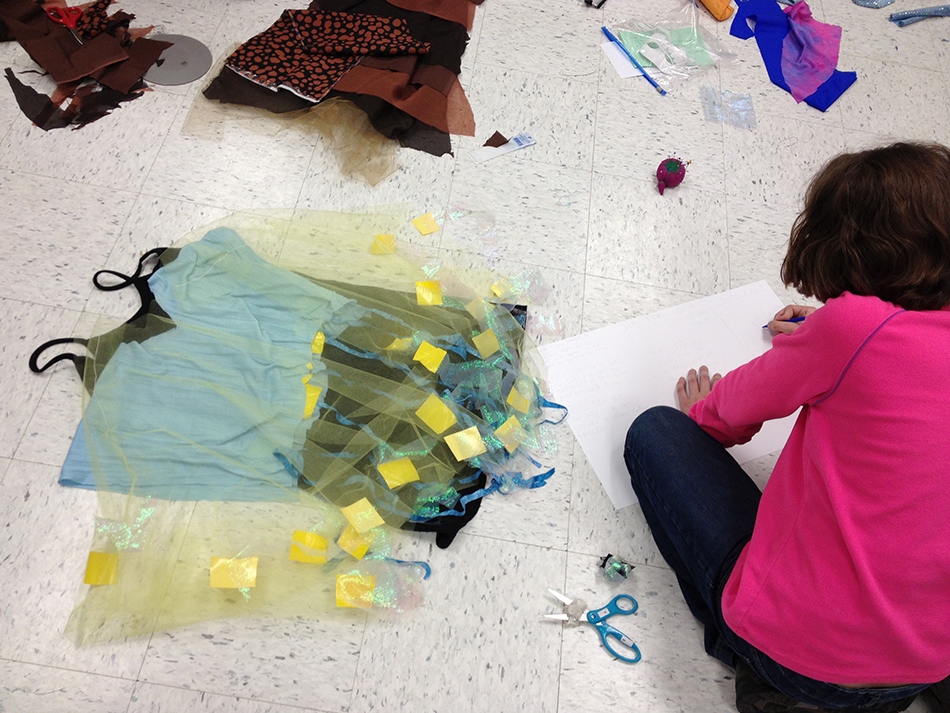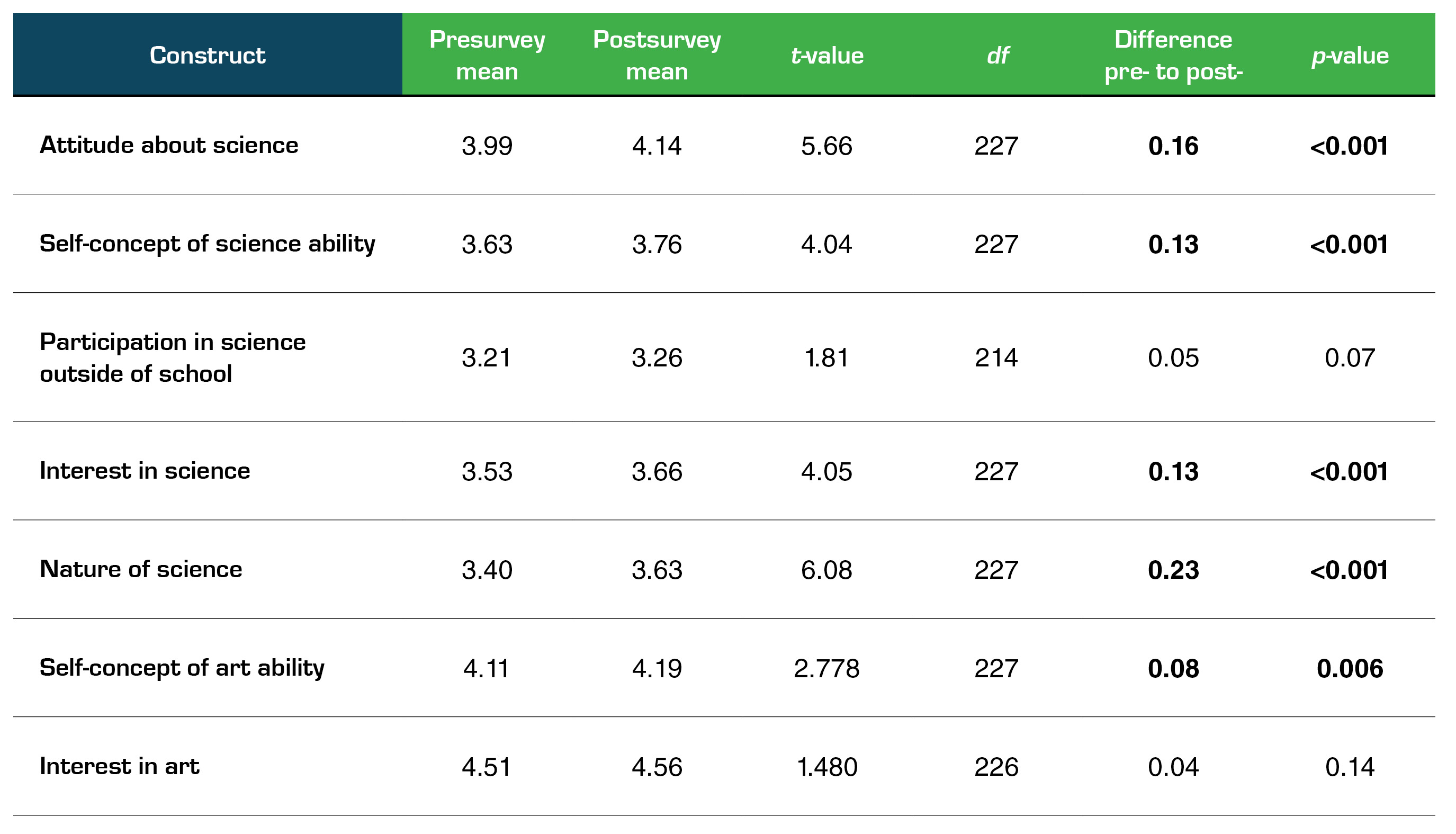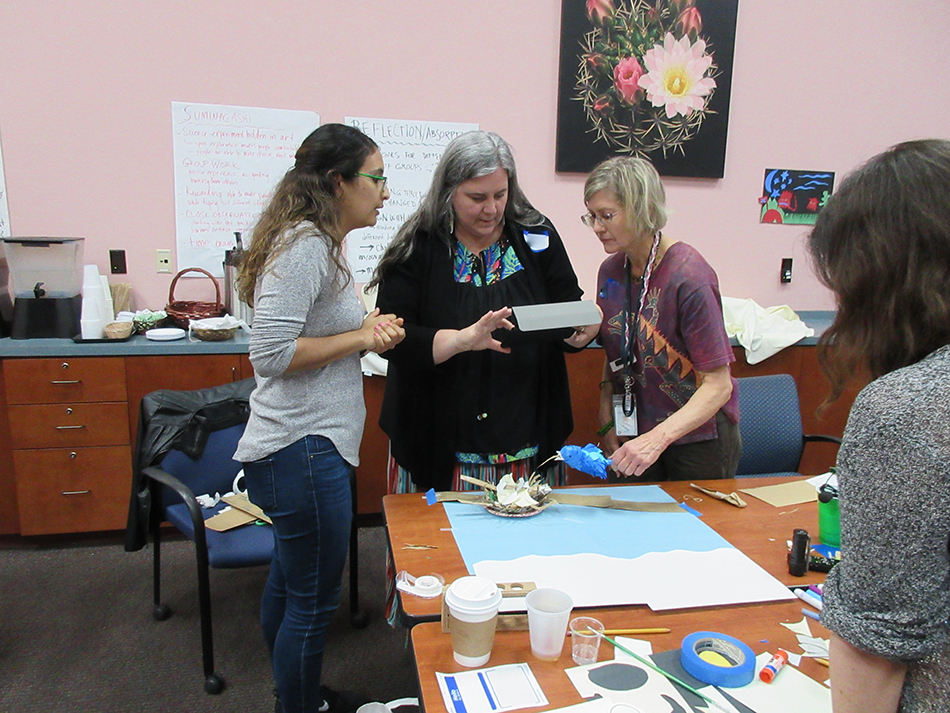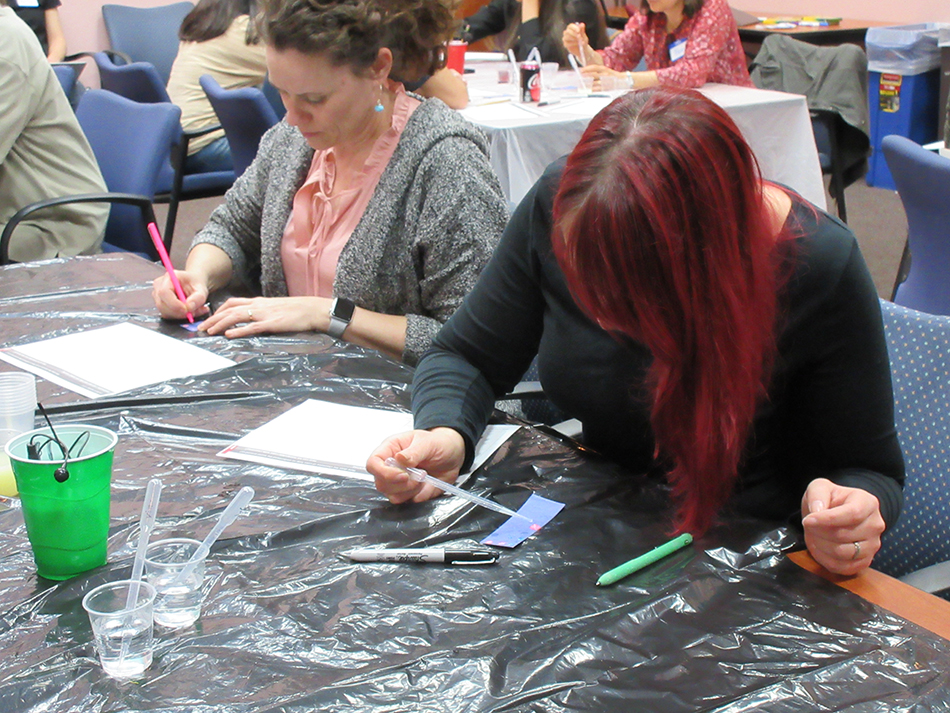Feature
Fostering a STEAM Mindset Across Learning Settings
Connected Science Learning October-December 2019 (Volume 1, Issue 12)
By Laura D. Carsten Conner, Blakely K. Tsurusaki, Carrie Tzou, Perrin Teal Sullivan, Mareca Guthrie, and Stephen M. Pompea
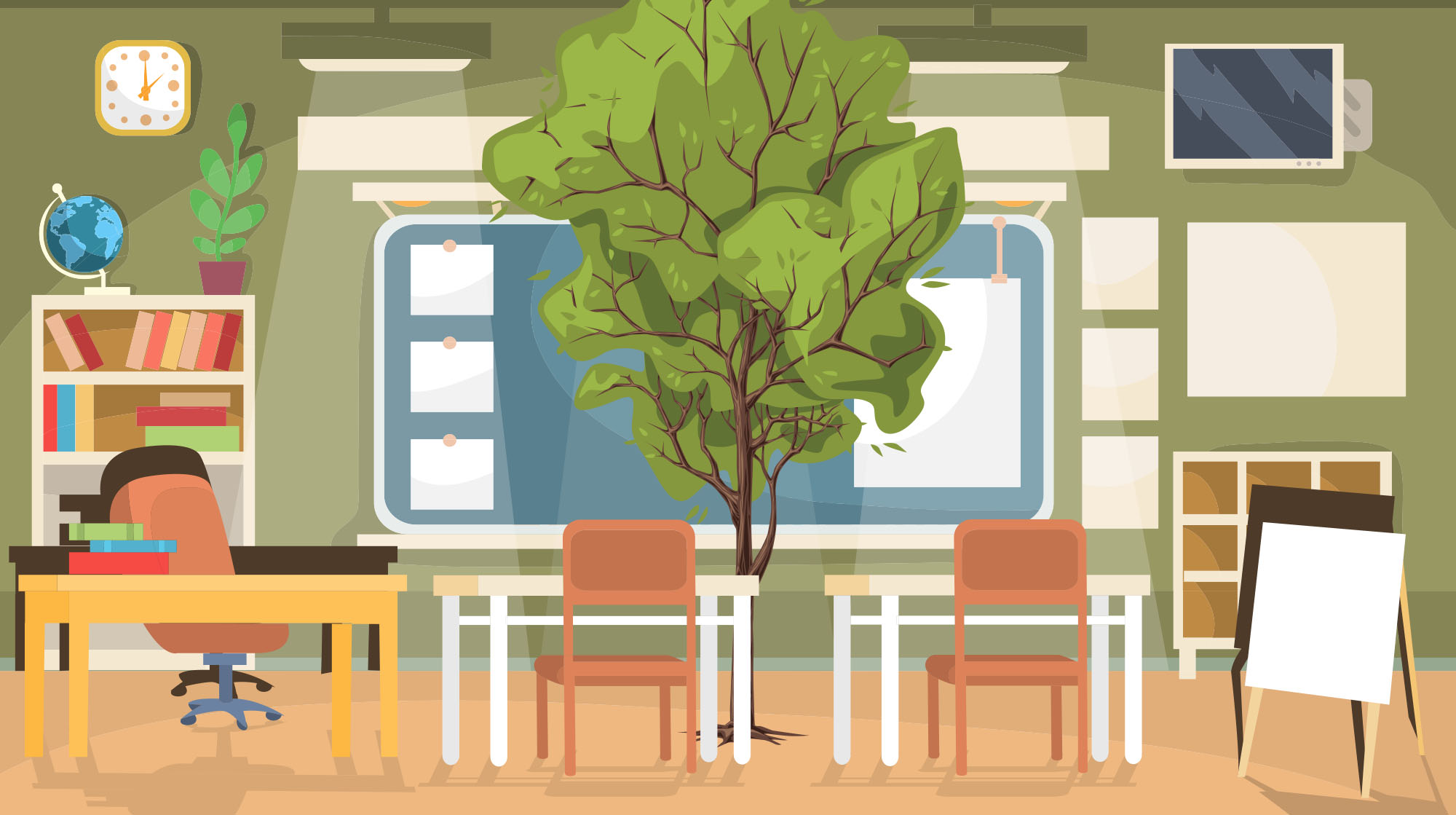
Developing a growth mindset has been identified as a key strategy for increasing youth achievement, motivation, and resiliency (Rattan et al. 2015). At its core, growth mindset describes the idea that one’s abilities can change through using new learning strategies and receiving appropriate mentoring (Dweck 2008). In contrast, a fixed mindset relates to the idea that ability is inherent and cannot be changed. We have taken up the concept of growth mindset and developed it specifically for the context of STEAM (science, technology, engineering, art, and math), a growing area of focus in both in- and out-of-school learning. We think of STEAM as more than just adding art to STEM or STEM to art—instead, we view STEAM as an approach that involves deep integration of overlapping art and STEM practices. Combining STEAM and the concept of mindset is especially helpful for intentionally bringing recognized identity-building features of out-of-school environments into the classroom, such as a sense of playfulness, open-ended exploration, and personal relevance. In this article we discuss our rationale and process in developing the concept of a “STEAM mindset” and illustrate how it can support youth and educator learning. Built on the foundations of the growth mindset concept, a STEAM mindset further emphasizes the ideas of quieting the inner negative voice, engaging in self-compassion rather than judgement, and promoting creative practice, as described in the sections below.
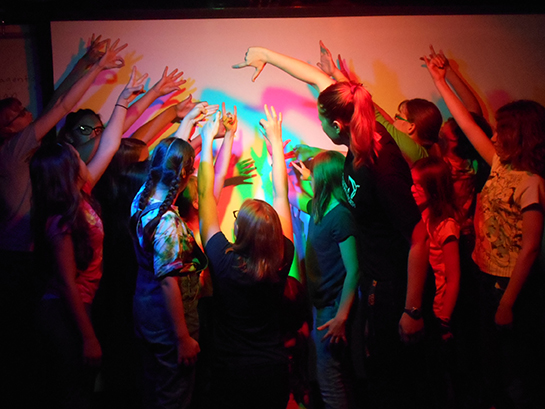
Overview: Connecting out-of-school and in-school learning
Our STEAM approach was developed over the course of seven years and has involved both out-of-school and in-school practitioners and settings. We initially developed our conceptions of STEAM mindset in out-of-school summer academies for youth. The next steps involved the development of STEAM kits drawn from the academies and modified for in-school use. A local school district adopted the kits and we provided professional development (PD) for teachers as they used these kits in their classrooms. The activities in the kits bring STEAM mindset to the classroom by leveraging features that are inherent to out-of-school learning. In the most recent phase of our work, we are partnering with several institutions to provide a full set of PD experiences for educators. The afterschool providers we reach work across in-school and out-of-school settings, implementing STEAM mindset–related programs in both. The in-school providers who complete our PD are expected to implement activities in both settings as well. Other out-of-school partners, such as science centers, in turn partner with in-school educators and community organizations to develop new STEAM programs based within, and supported by, our professional development framework. In these ways, our work has woven a tapestry of STEAM connections between in-school and out-of-school settings.
STEAM mindset in our work with youth
Our thinking about STEAM mindset began in the context of designing a two-week summer STEAM academy for upper elementary and middle school girls called The Colors of Nature. The academies were held in two locations, each of which hosted approximately 30–35 girls per year. We partnered with local school districts to recruit participants, working with the central administration to publicize the academies across the entire district. We set out to counter frequently held negative associations pertaining to science and art by designing a space where learners could engage with STEAM ideas and practices in ways that are personally relevant and meaningful. Our team recognized that learners (especially girls and youth from nondominant cultures) often experience science in a way that emphasizes memorizing facts, and as a result see it as something that is rote, passionless, and uncreative (e.g., Brotman and Moore 2008), and something that does not represent their own passions, cultural practices, or identities. Further, many youth come to see science as something that only “smart” people do, and they may experience social cues or other factors that lead to a low self-concept of their own science ability (Zeldin and Pajares 2000). Similarly, many youth have internalized societal views that portray artistic ability as a fixed trait, rather than something that can be developed. It is well-documented that youth start to emphasize realism in visual art around fourth grade and can give up if they feel that they cannot draw objects with complete accuracy (Burton 2009).
At the root of many of these ideas is a “negative inner voice” that tells learners that they are not capable. Research has shown that self-compassion, rather than self-judgment, can help quiet this negative inner voice and promote creative practice (e.g. Neff, Hsieh, and Dejitterat 2005; Zabelina and Robinson 2010). Recognizing these factors, we used intentional design strategies to support self-compassion, maximize creative practice, and quiet the negative voice. Some key commitments that guided the design were:
- Privileging creativity rather than rote practice
- Highlighting “mistakes” as opportunities for discovery
- Stressing the intrinsic value of process rather than product
- Focusing on activities with multiple possible outcomes
- Promoting enthusiasm and playfulness
- Building opportunities for youth to communicate about their work
We used iterative cycles of design and redesign for the academies over several years (Barab and Squire 2004) to establish an academy that included a number of “design challenges” that embodied these principles. Among other activities, girls
- developed stop-motion animations that explained the biological function of color;
- used chemistry to create a palette of colors with red cabbage extract, a chemical indicator of pH, then created paintings with that palette (Teal-Sullivan et al. 2017); and
- designed and sewed costumes that represented a real or fictional animal that had features derived from their explorations of optical science and biology.
The academy also had girls engage in close observation and drawing of real objects (e.g., butterflies, birds, feathers, shells) at multiple scales, focusing on the process of drawing rather than the end product. Although our design challenges focus specifically on the intersections of visual art, chemistry, optics, and biology, the STEAM mindset principles described here can be easily used within any STEAM area and with all learners, regardless of gender.
These activities embedded the key commitments highlighted above in several ways:
- Activities typically incorporated open-ended exploration, leveraging girls’ emerging questions and directions as they experimented with available materials. In this way, multiple outcomes were supported, rather than asking learners to search for the single “correct” answer to a problem.
- Iterating tasks and debriefing around design choices helped learners focus on the process of making, rather than on the product itself. To support learners in valuing mistakes as opportunities, the academy offered explicit discussion of famous innovations that resulted from “mistakes.” Iteration, a focus on process, and inclusion of activities with multiple outcomes also supported valuing mistakes as opportunities for discovery.
- Privileging creativity rather than rote practice was encouraged by offering design opportunities that were flexible and personally meaningful, rather than having girls create “cookie-cutter” artwork with a specific outcome.
- In terms of communication, all of the activities were characterized by opportunities for girls to share their work with others, again with a focus on the processes they used and the learning that this afforded. The academy culminated with an opportunity to position the girls as knowledgeable experts in their own science and art by having them present their final projects to their families, as well as practicing disciplinary professionals, during a public poster session.
Girls designed costumes based on a real or fictional animal with real biological features, and presented their costumes and posters to an audience of families and professionals.
We also included strategies that directly addressed the role of the negative inner voice through role-playing and other activities. Because this voice is internal, it is easy to give it credence, even though it often expresses unfounded judgments. Our team has observed that learners are often far more critical of their own abilities than they are of their peers’. “I can’t draw” and “I’m not good at math” are the kinds of sweeping statements readily directed at oneself or one’s own work, even if similar conditions would not elicit the same negative judgment of a peer. To help the girls become aware of their negative inner voice, we used a skit to conceptualize the negative voice as a factor that can actively be told to go away. In the skit, we would have the girls act out the process of drawing. Two actors would hover around an actor completing a drawing, acting as the “negative” and “positive” inner voices. The actor playing the negative voice would make statements such as, “That doesn’t look anything like a dog; you should just give up. You can’t draw.” The actor playing the positive voice would make statements such as, “Now wait a minute! This is the first time I have tried drawing a dog, and I think I’ve done a good job capturing the line of the tail. I think I can keep improving the more I practice.” In the skit, ultimately the positive voice would win by explicitly telling the negative voice to go away. This skit was a humorous and fun way to engage the girls in thinking about mindset.
Building on the skit, we used a “magic word” strategy, where learners helped monitor and reorient themselves and their peers when they noticed the negative voice arising, giving learners an explicit way to help manage the negative inner voice. The girls owned the strategy by each proposing potential words, then selecting a favorite through a blind vote to use throughout their time together. Learners were encouraged to shout out the word whenever they heard peers or facilitators expressing negative self-criticism, as a reminder to quiet the negative voice. This brought humor to the situation and engaged the group in a communal stewardship of not just their own, but also their peers’, STEAM mindset.
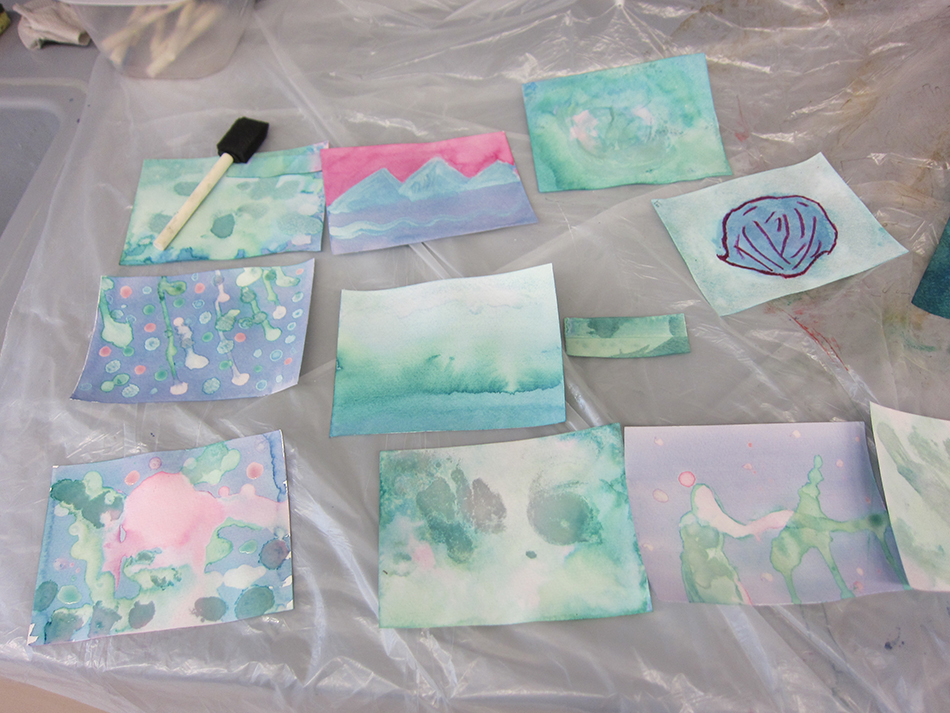
Evaluation of work with youth
Our evaluation of girls’ experiences in the academies was guided by concepts that are closely related to the idea of STEAM mindset, such as developing a positive self-concept about one’s own art and science practice, deepening one’s understanding and connection to foundational ideas about science and art, and increasing one’s interest and desire to continue both.
To evaluate these areas, we asked learners to rate items on pre-/postsurveys on seven Likert constructs. Respondents rated each item on a scale of Strongly Disagree (1), Disagree (2), Neutral (3), Agree (4), and Strongly Agree (5). Items that are negative were reverse-scored with a scale of Strongly Agree (1), Agree (2), Neutral (3), Disagree (4), and Strongly Disagree (5).
The reliability of our constructs was measured by calculating Cronbach’s alpha coefficient for each construct using SPSS Statistics software. Cronbach’s alpha is a measure of internal consistency among items included in a construct, and a value greater than 0.7 is considered evidence that the items included measure an underlying construct. Survey responses from all years and both locations were used in the calculations. All constructs are reliable.
We calculated pre- and postsurvey scale scores for each student by averaging the response value for the items that make up each construct, then we used a paired t-test to assess whether the means of the pre- and postsurvey scale scores were statistically different from each other. All constructs showed a statistically significant (p < 0.05) shift except interest in art, which was already high on the presurveys (Table 1), and participation in science outside of school, which was marginally significant (p < 0.1).
Table 1
Results from pre-/postsurveys, 2013–2016.
Differences in bold are significant. Construct items appear in Appendix A (see Supplementary Resources).
STEAM mindset work with educators
A natural progression of our work was bringing these ideas about STEAM and STEAM mindset to educators through kits and professional development activities. We extracted a subset of activities from the summer academies and further elaborated them so that an educator unfamiliar with the academies could facilitate each activity. This work resulted in a set of four kits for use in both in- and out-of-school settings, all of which contain core principles related to STEAM mindset. Kit 1 has a strong focus on the overlapping practices of art and science (observing, experimenting, questioning, analyzing, and describing), whereas our other kits look at the overlap of chemistry and art, biology and art, and optics and art, respectively. Key ideas in these last three kits include
- fundamentals of chemical reactions and intentional design of color palettes and art through chemistry;
- why and how animals and plants have color, and leveraging biological function of color to design camouflage patterns and stop-motion animations; and
- properties of white light and how these properties can be used intentionally to alter the visual experience of art.
The resulting lesson plans and supports are aligned with the Next Generation Science Standards and National Core Arts Standards, and are freely available.
In addition to the kits, we developed a PD series for educators. Initial work focused on in-school educators, using the activities in the kits to illustrate how open-ended exploration, playfulness, iteration, and open-ended outcomes can be used during STEAM activities to promote STEAM mindset. We then partnered with several out-of-school institutions, including libraries, science centers, and afterschool providers, to provide a full set of PD experiences for out-of-school–time educators. We added a fifth major partner composed of in-school art educators. As described above, these partners work across in- and out-of-school settings in various ways, either as educators who cross settings personally, or as institutions who partner with others in various settings. We offer two-day, in-person workshops, followed by an online PD series and continuing mentoring as the institutions develop new STEAM activities.
Educators work through the same design challenges as youth, giving an insider’s view of engaging in STEAM practices that support mindset.
At its heart, the PD work focuses on preparing educators to embed our key design commitments into their own STEAM programming. Through work with the kit activities, we ground our discussions and reflections on promoting STEAM mindset and identity among diverse learners. Part of this work is surfacing the barriers that youth face in engaging in science and art practice, but we also acknowledge that adults often hold similar views around their own science and art ability or content knowledge, which may lead to discomfort in facilitating such activities. With this in mind, we share core STEAM mindset strategies during the PD.
Early research outcomes with educators
Our work with educators is ongoing. However, our research has revealed some early outcomes suggesting that STEAM mindset is one of the primary areas that holds meaning for our PD participants. Although our training is about more than STEAM mindset, one of our partners refers to the training as the “STEAM mindset” training. One of the librarians who participated in the PD particularly took up the idea of valuing mistakes as opportunities for learning. She created a program based on this idea, setting the following goals for the youth (and adults):
- to discover the fun of mistakes, accept unpredictable outcomes, and exhibit playfulness;
- to learn how to iterate by making more than one drawing or creating a drawing with a friend, each taking turns building on the story; and
- to create personal meaning in their drawings, in part by sharing their stories with others.
The program she developed around these goals centered on a book called The Book of Mistakes, by Corrina Luyken. She began her program by reading the book to the group of intergenerational youth and adults. While reading the book, she emphasized the idea that mistakes can lead to surprising results and are not always negative. The group then discussed mistakes they had made in the past and how they led to something new and/or surprising. She told them that “mistakes are part of the creative process and are an important part of how artists and scientists discover new things.” Next, she provided the group with a variety of types of paper that had ink splotches on them. Each person used the ink splotch “mistakes” to create a drawing. The youth and adults each created multiple drawings, some of them creating many more, which they taped up on the “art gallery” wall. At the end of the program, they all shared how they turned the ink splotch mistakes into drawings. This program encouraged the youth and adults to think about mistakes as learning experiences that could be turned into something surprising and wonderful. They drew pictures that had personal meaning to them, including favorite patterns, animals, or hobbies such as music.
This example illustrates how STEAM mindset practices can be implemented in educators’ individual teaching and learning settings, and how they might hold value for educators working in STEAM. Preliminary survey results from another partner site indicate that beliefs about the importance of STEAM mindset increased more than 40% after the training, suggesting that the approach has value to educators in other settings, as well.
Conclusion
Our concept of a STEAM mindset approach, with its emphasis on design strategies that quiet the negative inner voice and promote self-compassion and creative engagement, has much potential for use in supporting diverse learners as they explore STEAM-related areas. We think the model can be helpful not only in both in- and out-of-school learning contexts, but also in making connections across the two by bringing key features of out-of-school environments into traditional classrooms.
Acknowledgments
We want to thank all of the Colors of Nature instructors who have participated over time, including Kyle Campbell, Gabrielle Vance, Laura Oxtoby, Alexis Will, Genevieve Johnson, Rob Sparks, Will Roddy, and Katie Kaleida, for their efforts in helping shape this work. We also wish to thank our institutional partners. This article is based upon work supported by the National Science Foundation under Grants No. 1713155, 1713276, 1224020, and 1223363. Any opinions, findings, and conclusions or recommendations expressed in this material are those of the author(s) and do not necessarily reflect the views of the National Science Foundation. The National Optical Astronomy Observatory is operated by the Association of Universities for Research in Astronomy Inc. under a cooperative agreement with the National Science Foundation.
Laura D. Carsten Conner (ldconner@alaska.edu) is research associate professor of science education in the Geophysical Institute and the College of Natural Science and Mathematics at the University of Alaska Fairbanks in Fairbanks, Alaska. Blakely K. Tsurusaki (btsuru@uw.edu) is a senior research scientist with the Goodlad Institute for Educational Renewal at the University of Washington Bothell in Bothell, Washington. Carrie Tzou (tzouct@uw.edu) is an associate professor of science education and director of the Goodlad Institute for Educational Renewal in the School of Educational Studies at the University of Washington Bothell in Bothell, Washington. Perrin Teal Sullivan (pteal@uw.edu) is a STEAM designer at the Goodlad Institute of Educational Renewal at the University of Washington Bothell in Bothell, Washington. Mareca Guthrie (mrguthrie@alaska.edu) is curator of fine arts at the University of Alaska Museum of the North and associate professor of art at the University of Alaska Fairbanks in Fairbanks, Alaska. Stephen M. Pompea (spompea@noao.edu) is observatory scientist and head of the education and public outreach program at the National Optical Astronomy Observatory in Tucson, Arizona, and La Serena, Chile.



